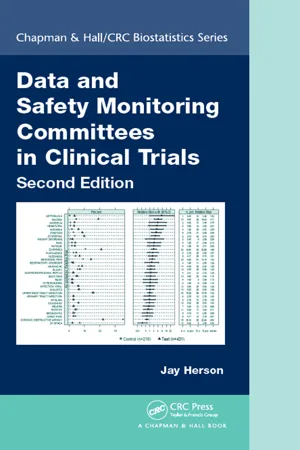
- 241 pages
- English
- ePUB (mobile friendly)
- Available on iOS & Android
Data and Safety Monitoring Committees in Clinical Trials
About this book
Praise for the first edition:
"Given the author's years of experience as a statistician and as a founder of the first DMC in pharmaceutical industry trials, I highly recommend this book—not only for experts because of its cogent and organized presentation, but more importantly for young investigators who are seeking information about the logistical and philosophical aspects of a DMC."
-S. T. Ounpraseuth, The American Statistician
In the first edition of this well-regarded book, the author provided a groundbreaking and definitive guide to best practices in pharmaceutical industry data monitoring committees (DMCs). Maintaining all the material from the first edition and adding substantial new material, Data and Safety Monitoring Committees in Clinical Trials, Second Edition is ideal for training professionals to serve on their first DMC as well as for experienced clinical and biostatistical DMC members, sponsor and regulatory agency staff.
The second edition guides the reader through newly emerging DMC responsibilities brought about by regulations emphasizing risk vs benefit and the emergence of risk-based monitoring. It also provides the reader with many new statistical methods, clinical trial designs and clinical terminology that have emerged since the first edition. The references have been updated and the very popular end-of-chapter Q&A section has been supplemented with many new experiences since the first edition.
New to the Second Edition:
-
- Presents statistical methods, tables, listings and graphs appropriate for safety review, efficacy analysis and risk vs benefit analysis, SPERT and PRISMA initiatives.
-
- Newly added interim analysis for efficacy and futility section.
-
- DMC responsibilities in SUSARs (Serious Unexpected Serious Adverse Reactions), basket trials, umbrella trials, dynamic treatment strategies /SMART trials, pragmatic trials, biosimilar trials, companion diagnostics, etc.
-
- DMC responsibilities for data quality and fraud detection (Fraud Recovery Plan)
-
- Use of patient reported outcomes of safety
-
- Use of meta analysis and data outside the trial
-
- New ideas for training and compensation of DMC members
Jay Herson is Senior Associate, Biostatistics, Johns Hopkins Bloomberg School of Public Health where he teaches courses on clinical trials and drug development based on his many years experience in clinical trials in academia and the pharmaceutical industry.
Frequently asked questions
- Essential is ideal for learners and professionals who enjoy exploring a wide range of subjects. Access the Essential Library with 800,000+ trusted titles and best-sellers across business, personal growth, and the humanities. Includes unlimited reading time and Standard Read Aloud voice.
- Complete: Perfect for advanced learners and researchers needing full, unrestricted access. Unlock 1.4M+ books across hundreds of subjects, including academic and specialized titles. The Complete Plan also includes advanced features like Premium Read Aloud and Research Assistant.
Please note we cannot support devices running on iOS 13 and Android 7 or earlier. Learn more about using the app.
Information
Table of contents
- Cover
- Half Title
- Title Page
- Copyright Page
- Dedication
- Table of Contents
- Preface to the First Edition
- Preface to the Second Edition
- List of Abbreviations
- 1 Introduction
- 2 Organization of a Safety Monitoring Program for a Confirmatory Trial
- 3 Meetings
- 4 Clinical Issues
- 5 Statistical Issues
- 6 Bias and Pitfalls
- 7 Data Monitoring Committee Decisions
- 8 Emerging Issues
- Glossary
- Appendix
- References
- Index